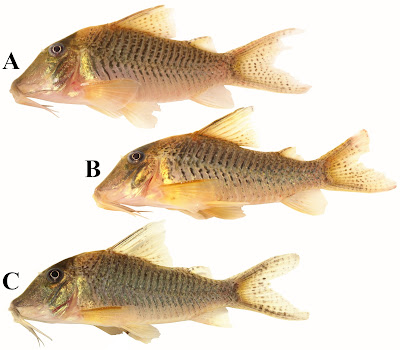Abstract
A new species of Corydoras is described from the rio Xingu and rio Tapajós basins, Pará State, Brazil. The new species can be promptly distinguished from its congeners by the combination of the following features: (I) temporal sensory canal at sphenotic with two pores; (II) upper tooth plate of branchial arch with three or four series of teeth; (III) area at the corner of the mouth, ventral to the maxillary barbel, with a small, roughly triangular fleshy flap, not forming an elongated barbel-like structure; (IV) contact between posterior process of the parieto-supraoccipital and nuchal plate; (V) dark stripe transversally crossing the orbit, forming a mask-like blotch; (VI) absence of a distinct color pattern along midline of flank; (VII) dorsolateral body plates only with small, irregular, rounded or vertically elongated dark brown or black blotches; ground color of plates typically dusky but not forming large, conspicuous black patches; and (VIII) absence of a relatively large, conspicuous dark patch on anterior portion of dorsal fin.
Keywords: Corydoradinae; Corydoras sp. CW83; Jacareacanga; Taxonomy; Volta Grande do Xingu
Corydoras caramater, new species
Diagnosis: Corydoras caramater can be distinguished from its congeners, except for the species within the lineage 1 sensu Alexandrou et al. (2011), by the presence of the following features: branch of the temporal sensory canal at sphenotic, which gives rise to the supraorbital canal, with two pores (vs. one pore); upper tooth plate of branchial arch with three or four series of teeth (vs. two series); and area at the corner of the mouth, ventral to the maxillary barbel, with a small fleshy flap (vs. fleshy flap absent); from the lineage 1 species, except for C. amapaensis Nijssen, 1972, C. blochi Nijssen, 1971, C. cortesi Castro, 1987, C. desana Lima & Sazima, 2017, C. pastazensis Weitzman, 1963, C. saramaccensis Nijssen, 1970, C. septentrionalis Gosline, 1940, C. serratus Sands, 1995, C. solox Nijssen & Isbrücker, 1983, and C. simulatus Weitzman & Nijssen, 1970, by having a dark brown or black patch transversally crossing the orbit, forming a mask-like blotch, which can be variably diffuse (vs. mask-like blotch absent); it differs from C. cortesi, C. desana, C. pastazensis, C. septentrionalis, and C. simulatus by the absence of a distinct color pattern along midline of flank (vs. midline of flank with moderate- to large-sized, conspicuous dark brown or black blotches in C. desana, C. pastazensis, C. septentrionalis, and C. simulatus; with a longitudinal dark brown or black stripe in C. cortesi); from C. amapaensis, C. serratus and C. solox, it differs by having dorsolateral body plates only with small, irregular, rounded or vertically elongated dark brown or black blotches; ground color of plates typically dusky but not forming large, conspicuous black patches (vs. midventral portion of dorsolateral body plates on region between middle portion of dorsal fin and caudal-fin base typically with large, conspicuous dark brown or black longitudinally elongated blotch or stripe; dark stripe variably diffuse, in C. amapaensis; wide, dark brown or black longitudinal stripe from predorsal region to caudal-fin base or, alternatively, dorsolateral body plates around anterior portion of dorsal-fin base with dark brown or black patch in C. serratus; region between anterior portion of dorsal fin and caudal-fin base with wide, longitudinal dark brown or black stripe in C. solox); from C. blochi and C. saramaccensis by the absence of a relatively large, conspicuous dark patch on anterior portion of dorsal fin (vs. anterior portion of dorsal fin with a conspicuous concentration of dark brown or black chromatophores, forming a relatively large, conspicuous patch). Additionally, Corydoras caramater can be distinguished from C. geoffroy Lacépède, 1803, C. amapaensis, C. septentrionalis, and C. solox by having a triangular fleshy flap at the corner of mouth, ventrally to maxillary barbel, not forming an elongated barbel-like structure (vs. fleshy flap at corner of mouth elongated, forming a barbel-like structure).
Etymology. The specific epithet caramater is formed by the junction of two words derived from the Latin ‘cara’, which means dear, beloved, and ‘mater’, meaning mother. This is a small tribute to these strong women, who work hard and are still responsible, often alone, for tenderly raising their children. The name especially honors Miriam Tencatt, Jéssica Mendonça (mother and wife of LCFT, respectively), Ireide da Silva Pinto (mother of OLPC), Vanda Santos (in memorian), Roberta Murta-Fonseca (mother and wife of SAS, respectively), and Edina Melo de Sousa (mother of LMS), but extends to all caring mothers around the world. A noun in apposition.
L.F.C. Tencatt, Couto O.L.P., Santos S.A. and Sousa L.M. 2024. A New long-snouted Corydoras (Siluriformes: Callichthyidae) from the rio Xingu and rio Tapajós Basins, Brazilian Amazon. Neotrop. ichthyol. 22(1); DOI: 10.1590/1982-0224-2023-0112


